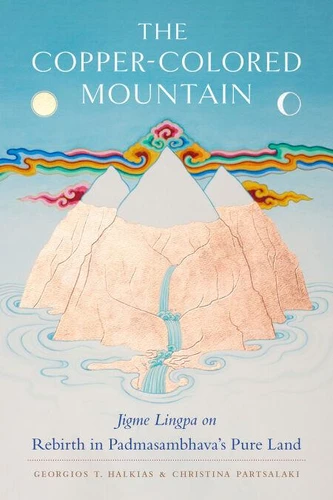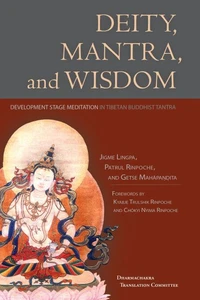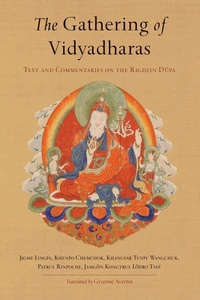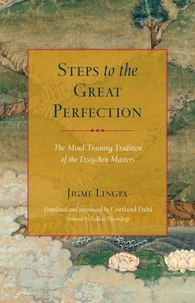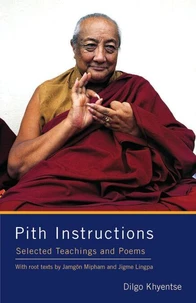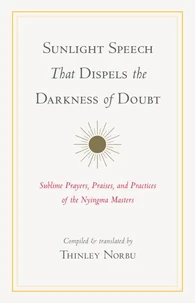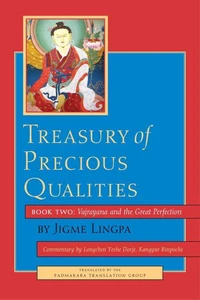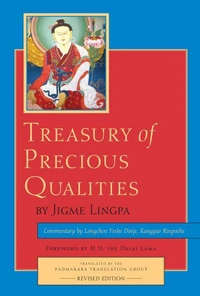The Copper - Colored Mountain. Jigme Lingpa on Rebirth in Padmasambhava's Pure Land
Par : , ,Formats :
Disponible dans votre compte client Decitre ou Furet du Nord dès validation de votre commande. Le format ePub protégé est :
- Compatible avec une lecture sur My Vivlio (smartphone, tablette, ordinateur)
- Compatible avec une lecture sur liseuses Vivlio
- Pour les liseuses autres que Vivlio, vous devez utiliser le logiciel Adobe Digital Edition. Non compatible avec la lecture sur les liseuses Kindle, Remarkable et Sony
- Non compatible avec un achat hors France métropolitaine
 , qui est-ce ?
, qui est-ce ?Notre partenaire de plateforme de lecture numérique où vous retrouverez l'ensemble de vos ebooks gratuitement
Pour en savoir plus sur nos ebooks, consultez notre aide en ligne ici
- Nombre de pages208
- FormatePub
- ISBN978-0-8348-4437-7
- EAN9780834844377
- Date de parution01/11/2022
- Protection num.Adobe DRM
- Taille3 Mo
- Infos supplémentairesepub
- ÉditeurSnow Lion
Résumé
A translation of Jigme Lingpa's eighteenth-century Tibetan Buddhist aspiration prayer for taking rebirth in the pure land Copper-Colored Mountain, accompanied by a commentary and analysis by the translators. While Pure Land Buddhism is generally thought of as an East Asian tradition with an Indian origin, the Copper-Colored Mountain is in fact the first and only pure land with scriptural origins entirely in the Tibetan tradition.
It represents Tibetan culture's fascinating intersection of traditional history with liturgical tantric practice. The Copper-Colored Mountain is understood to be the current abode of Padmasambhava, the Indian master credited with first bringing Buddhism to Tibet and founding Tibet's first monastery, Samye. After leaving Tibet, it is said that Padmasambhava set up residence on Camara, one of the two islands on either side of the continent of Jambudvipa, our world according to Buddhist cosmology.
After taming the resident ogres of Camara and converting them to Buddhism, he then built an octagonal palace where Buddhist practitioners may be transported in visions and dreams or reborn through aspiration prayers. This work is a translation and analysis of one such aspiration prayer. This prayer was composed by Jigme Lingpa, a treasure revealer of the Nyingma tradition in the eighteenth century and remains the most important prayer to this pure land in Tibetan Buddhism. Merging academic precision in representing the Tibetan texts and devotion to the principles of tantric Buddhism, translators Georgios T.
Halkias and Christina Partsalaki enable a wider appreciation of the history and impact of this prayer in Tibetan Buddhist literature while elucidating its meaning for Buddhist practitioners.
It represents Tibetan culture's fascinating intersection of traditional history with liturgical tantric practice. The Copper-Colored Mountain is understood to be the current abode of Padmasambhava, the Indian master credited with first bringing Buddhism to Tibet and founding Tibet's first monastery, Samye. After leaving Tibet, it is said that Padmasambhava set up residence on Camara, one of the two islands on either side of the continent of Jambudvipa, our world according to Buddhist cosmology.
After taming the resident ogres of Camara and converting them to Buddhism, he then built an octagonal palace where Buddhist practitioners may be transported in visions and dreams or reborn through aspiration prayers. This work is a translation and analysis of one such aspiration prayer. This prayer was composed by Jigme Lingpa, a treasure revealer of the Nyingma tradition in the eighteenth century and remains the most important prayer to this pure land in Tibetan Buddhism. Merging academic precision in representing the Tibetan texts and devotion to the principles of tantric Buddhism, translators Georgios T.
Halkias and Christina Partsalaki enable a wider appreciation of the history and impact of this prayer in Tibetan Buddhist literature while elucidating its meaning for Buddhist practitioners.
A translation of Jigme Lingpa's eighteenth-century Tibetan Buddhist aspiration prayer for taking rebirth in the pure land Copper-Colored Mountain, accompanied by a commentary and analysis by the translators. While Pure Land Buddhism is generally thought of as an East Asian tradition with an Indian origin, the Copper-Colored Mountain is in fact the first and only pure land with scriptural origins entirely in the Tibetan tradition.
It represents Tibetan culture's fascinating intersection of traditional history with liturgical tantric practice. The Copper-Colored Mountain is understood to be the current abode of Padmasambhava, the Indian master credited with first bringing Buddhism to Tibet and founding Tibet's first monastery, Samye. After leaving Tibet, it is said that Padmasambhava set up residence on Camara, one of the two islands on either side of the continent of Jambudvipa, our world according to Buddhist cosmology.
After taming the resident ogres of Camara and converting them to Buddhism, he then built an octagonal palace where Buddhist practitioners may be transported in visions and dreams or reborn through aspiration prayers. This work is a translation and analysis of one such aspiration prayer. This prayer was composed by Jigme Lingpa, a treasure revealer of the Nyingma tradition in the eighteenth century and remains the most important prayer to this pure land in Tibetan Buddhism. Merging academic precision in representing the Tibetan texts and devotion to the principles of tantric Buddhism, translators Georgios T.
Halkias and Christina Partsalaki enable a wider appreciation of the history and impact of this prayer in Tibetan Buddhist literature while elucidating its meaning for Buddhist practitioners.
It represents Tibetan culture's fascinating intersection of traditional history with liturgical tantric practice. The Copper-Colored Mountain is understood to be the current abode of Padmasambhava, the Indian master credited with first bringing Buddhism to Tibet and founding Tibet's first monastery, Samye. After leaving Tibet, it is said that Padmasambhava set up residence on Camara, one of the two islands on either side of the continent of Jambudvipa, our world according to Buddhist cosmology.
After taming the resident ogres of Camara and converting them to Buddhism, he then built an octagonal palace where Buddhist practitioners may be transported in visions and dreams or reborn through aspiration prayers. This work is a translation and analysis of one such aspiration prayer. This prayer was composed by Jigme Lingpa, a treasure revealer of the Nyingma tradition in the eighteenth century and remains the most important prayer to this pure land in Tibetan Buddhism. Merging academic precision in representing the Tibetan texts and devotion to the principles of tantric Buddhism, translators Georgios T.
Halkias and Christina Partsalaki enable a wider appreciation of the history and impact of this prayer in Tibetan Buddhist literature while elucidating its meaning for Buddhist practitioners.

